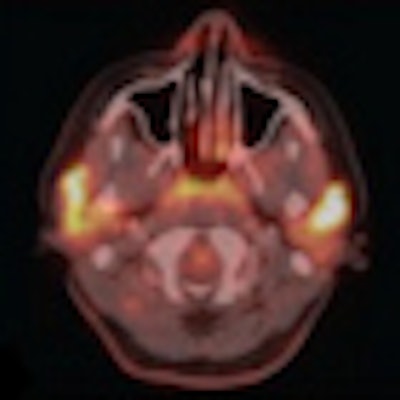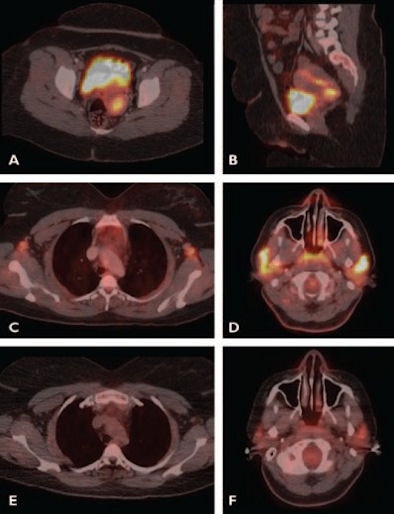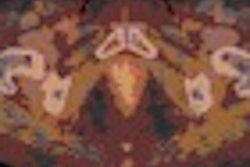
Despite an abundance of false-positive results, FDG-PET/CT can provide "valuable insight" into the progression of disease in HIV patients without the need for biopsy, according to a paper in the August issue of the American Journal of Roentgenology.
The researchers from Boston Medical Center (BMC) also concluded that clinicians can use the modality to distinguish between malignancy and infection when evaluating central nervous system lesions, leading to appropriate treatment initiation and precluding the need for invasive biopsy (AJR, August 2011, Vol. 197:2, pp. 284-293).
The research review, led by medical student Jessica Davison, began soon after BMC completed the construction of a new facility in 2006 that housed imaging, oncology, and surgery under one roof. Those clinical services were consolidated in part because BMC had a high percentage of patients with both HIV and cancer.
"Even though there is a variety of confounding variables and pitfalls, particularly false-positive scans, FDG-PET/CT scans are very useful because they tend to be very sensitive in picking up disease," said study co-author Dr. Gustavo Mercier, chief of molecular imaging and nuclear medicine at BMC. "The question is sorting out what happens to be cancer and what happens to be infection."
Imaging challenge
HIV patients can be more challenging to image than other patients because the HIV virus activates lymph nodes that are detected by PET. As noted in the study, with HIV infection, resting lymphocytes are activated, increasing their glucose uptake by as much as 20 times over 24 hours. As a result, the increased activity raises FDG uptake, creating a false-positive PET image.
"We knew that one of the biggest problems we were going to confront in dealing with these patients is that they would have many false positives, because they tend to have a lot of infection," Mercier added. "We also know from the literature that the HIV virus would activate lymphocytes, and that also would be a source of false-positive scans."
Previous studies have found that neurologic complications also occur frequently in HIV-positive patients, due to infection, malignancy, or the virus itself, the study authors wrote. Other literature has estimated that as many as 10% of AIDS patients will initially present with neurologic symptoms, and between 40% and 60% of AIDS patients will eventually develop central nervous system complications during the course of their disease.
 |
| Images are of a 31-year-old woman with HIV who was evaluated for initial staging of biopsy-proven stage IIIB squamous cell carcinoma of the cervix. Axial (A) and sagittal (B) fused PET/CT images show F-18 FDG uptake in cervix with maximum standardized uptake value of 8.3, consistent with patient’s known malignancy, along with increased FDG uptake in bilateral axillary lymph nodes (C) and markedly increased FDG uptake bilaterally in parotids (D) due to reactive changes from HIV. Postchemotherapy FDG-PET/CT scans show no uptake in bilateral axillary lymph nodes (E) and markedly less activity in parotids (F), consistent with benign uptake. Images courtesy of the American Journal of Roentgenology. |
PML effect
Mercier said one of the more interesting findings in the review was an HIV-related condition called progressive multifocal leukoencephalopathy (PML), which is caused by a virus in the central nervous system and can adversely affect the brain in patients with lowered immunity defenses. Traditionally, these lesions may not be seen as significant edema on MRI and CT.
A 1996 study by researchers at Duke University analyzed FDG-PET scans of 18 HIV-positive patients with focal central nervous system lesions as detected by CT or MRI scans. The study included eight patients with infectious lesions, five patients with biopsy-proven central nervous system lymphoma, and five patients with presumed central nervous system lymphoma (Heald et al, International Journal of STD and AIDS, August-September 1996, Vol. 7:5, pp. 337-346).
The Duke researchers found that lymphoma had a significantly higher FDG uptake than other infectious processes in 16 of 18 cases, while high FDG uptake was seen in two cases of PML, which could not be differentiated from lymphoma. Their conclusion was that "FDG-PET shows great promise in differentiating lymphoma from infectious lesions in the [central nervous system] of patients with HIV infection."
HAART treatment
Mercier and colleagues also noted that FDG-PET/CT has potential as a noninvasive way to monitor patient response to highly active antiretroviral therapy (HAART) and its potential side effects. In recent years, HAART has greatly reduced HIV-associated morbidity and mortality among HIV patients.
While some patients with early and advanced HIV have shown increased FDG uptake in peripheral nodes, patients on HAART showed no significant nodal FDG uptake. "The ability of HAART to markedly reduce viral load has implications for the evaluation of HIV-positive patients with FDG-PET," the authors wrote.
"We are not claiming that you can use FDG-PET/CT to watch and monitor the use of HAART therapy, but we feel there may be some research that should be done in order to validate the opportunity to follow patients, study the pathophysiology of HIV infection, and look at how people respond to therapy," Mercer said. "Particularly, it may take care of that small group of people who do not seem to respond to therapies very well."
Don't shy away
Among the messages Mercier and his colleagues want to convey is that FDG-PET/CT can be very useful for imaging HIV patients, and clinicians should not shy away from the modality due to false-positive results.
"The first knee-jerk reaction, particularly of radiologists and nuclear medicine physicians, is 'Oh my god, these scans are going to be awful,' " he said. "Although there is a need for further research, a review of the literature does show there are some niches where this imaging technology can have a very nice role, not just on the clinical side, but also to address research questions in the pathophysiology of HIV disease and in the effort to develop therapeutic drugs."




















